“We are proud of our vinegar.” Federica Gibellini is leading me and my husband on a tour of the Acetaia Leonardi balsamic vinegar farm. Leonardi is a family owned balsamic maker in Magreta, Italy in the area surrounding Modena, home to traditional balsamic vinegar production. It’s in the Emilia-Romagna region, also known for Parmigiano Reggiano cheese and Proscuitto di Parma. The Leonardi family established their business in 1871 and since then their vinegars have become not just well-regarded but famous too, being the choice of royalty, even served at Kate and William’s wedding.
Unlike many balsamic vinegar makers Leondari is a “closed cycle” farm, meaning they grow and tend their own grapes, harvest, ferment, age, bottle and sell the balsamic vinegar all on their own property. That’s an important distinction in the quality and flavor of their vinegar.
“We are four generations who produce this special vinegar,” says Federica. She’s in the family, as she says, since her uncle is the Master Taster, who she calls the master of vinegar.
“Mr. Giovanni Leonardi is the person who knows all the rules and all the secrets,” says Federica. “We can’t do anything without his permission.” The Master Taster oversees every aspect of balsamic vinegar production, from the vineyard to cooking the grape must to barrel aging and bottling.
“The word balsamico comes from a Greek word balsama that means medicine and the vinegar is good for your body,” says Federica. Aceto Balsamico Tradizionale di Modena is a defined D.O.P., Denominazione di Origine Protetta, a protected region of origin. To be an Aceto Balsamico Tradizionale di Modena D.O.P. means it is made only in the province of Modena and is made only of acetified cooked grape must, aged at least 12 years. D.O.P balsamico certifies a limited number of bottles allowed every year and each bottle will bear the seal of guarantee. All D.O.P vinegars must be certified by the Consorzio Produttori Aceto Balsamic Tradizionale di Modna.
You will also find Aceto Balsamico di Modena I.G.P. (Protected Geographical Indication), a classification of vinegar that Leonardi also makes. It it aged for much less time and is also less expensive. The cooked grape must is blended with wine vinegar. In lesser quality brands you will also see caramel and or other colorings added.
There are also balsamic vinegar condimento products, which Leonardi also makes. The vinegar is made in the same method of traditional balsamic vinegar, but usually not aged as long as I.G.P. and D.O.P. vinegar (although in some cases you see 30 year old condimento as at Leonardi). Condimento does not need to go through any certifications. Condimentos are a delicious alternative to more expensive balsamic vinegars.
Federica tells us you only need four things to make an outstanding traditional balsamic vinegar: grapes, weather, wood and time.” There are only two kinds of grapes: Trebbiano, a white and Lambrusco, a red (both sightly sweet). Weather means a very hot summer and a very cold winter. The cold is needed, especially early on, to make a slow fermentation of the must into vinegar. Balsamic needs hot weather for evaporation, which concentrates the vinegar. Wood is the types of wood that make the barrels used to age the balsamic vinegar and time is just that, time. It takes at least three to five years for a young balsamic to be ready. At Leonardi the youngest vinegar they make is three years old, but they also make a 10, 12, 25, 30, 100 and even 150 year old balsamic. A balsamic vinegar less than 12 years old but at least six years old will be an I.G.P. vinegar.
When the Trebbiano and Lambrusco grapes are harvested, they are gentle crushed to produce a mosto or must, consisting of grape juice, skins and seeds. Then the must goes into a stainless steel pot and is heated (but not boiled). “We cook [the must] for 36 to 48 hours at a temperature of about 85ºF,” says Federica. “At the end of cooking we obtain a sort of grape juice with thickness called cooked grape must (mosto d’uva cotto) and it is our only [raw] ingredient.”
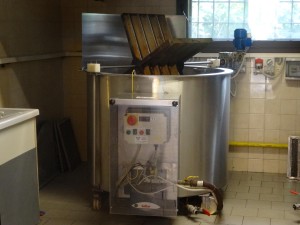
But the must isn’t vinegar yet. Once the must is finished cooking it is put into large oak casks that hold 6500 liters of vinegar. Once it is “acetified,” meaning acetic acid is added to it, the must begins to ferment in the barrel, turning into vinegar. As the vinegar ferments, it is also reducing in volume, concentrating the sugar and the sweetness as it ages. The oak also adds a vanilla aroma to the vinegar. After about 14 months the vinegar is moved into medium sized casks. “The vinegars spends its whole life passing through different types of wood,” says Federica. The next step is moving the vinegar from the medium casks to a series of smaller barrels called a battery where it will spend many years being transformed into balsamic vinegar.
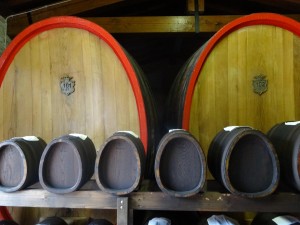
A battery is made up of at least nine barrels of different types of wood. As the vinegar ages it is moved from barrel to barrel until it reaches the desired age. Each wood type adds a different flavor: Cherry is fruity, juniper is spicy. There’s also chestnut, ash and mulberry. The vinegar also reduces in volume due to the natural evaporation of water, making it thicker and sweeter.
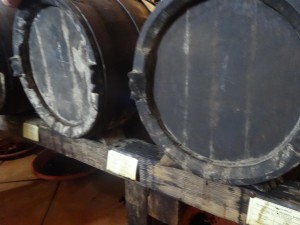
Some of the barrels at Leonardi date back to its founding – 1781 – and are still used to age vinegar. Every barrel has its on ID: the barrel number, type of wood, and how much vinegar was put inside the cask.
“When this barrel was created we know it was between 1781 and 1820, and when people put inside the vinegar for the first time was in 1818,” says Federica. Amazing that they keep records like that.
We get to taste the vinegar inside, a 30 year old balsamic. The vinegar has a very complex aroma of cherry, spice, honey and plum. It’s thick like syrup and dark brown. You get sweetness followed by acidity. Mmmmm. This is the best vinegar I’ve ever had. “A 30 years old balsamic like this one is perfect with parmesan cheese and also with ice cream and strawberries, really tasty” Federica says.
Then we get to taste a 100 year old vinegar. It comes out of a barrel that looks pretty funky, but looks are deceiving because the vinegar is super thick, syrupy and absolutely delicious. It is sweet and complex, intense and intoxicating. One drop is all you need.
A young vinegar that’s three to five years old will be more tart and bitter than one that is older and sweeter. Young vinegars are perfect for daily use on salads, vegetables and bread.
Balsamic that is 10 to 20 years old is sweeter and thicker and perfect with pasta. It’s also good drizzled on fish, meat and young, soft cheese.
Should you find yourself near Modena, you can visit the Acetaia Leonardi by appointment 7 days a week. You’ll get a tour of the balsamic vinegar farm and you get to sample not just the balsamic vinegar, but the other vinegar products that Leonardi makes. It’s an informative and tasty tour.
To make sure you know you are buying authentic traditional balsamic vinegar, check out this buying guide. You can find Leonardi balsamic vinegar at The Pasta Shop in Berkeley and Oakland and on their website Market Hall Foods.

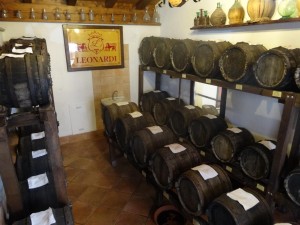
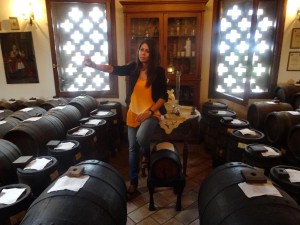
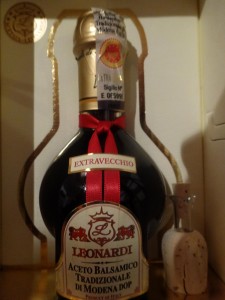
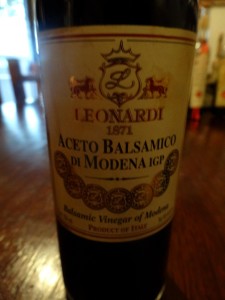
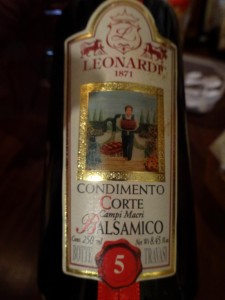
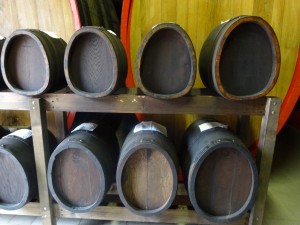
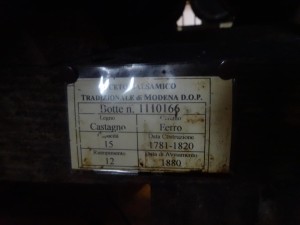
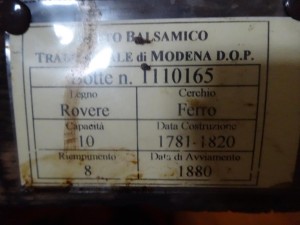
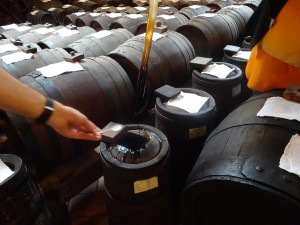
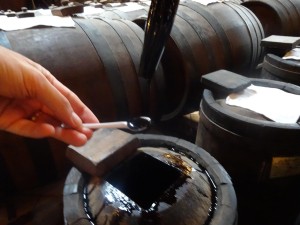
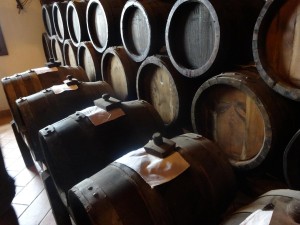

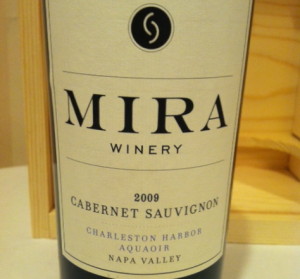
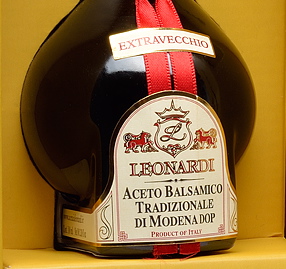
3 Comments
Pingback: Make Sure You’re Buying The Real Thing – Shopping Tips For Traditional Balsamic Vinegar | WineFashionista
Avez vous une grille tarifaire ? Merci. Cordialement. Benoit chalon.
Pas désolé, je ne sais pas.